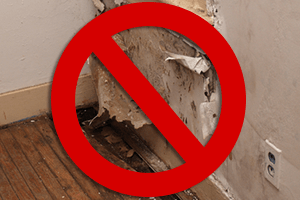Moisture, Mold and Mildew: How to Combat the 3 M’s

Moisture:
- The culprit and cause of mold and mildew, moisture can seep into walls and floors causing damage to structure as well as a perfect environment for fungus to thrive. There are a few things you can do to avoid moisture being trapped in your home.
- Check your plumbing and gutters. Leaky pipes, a burst or even ineffective gutters can allow water to leak into your home and collect. Simple maintenance will help prevent this from happening. Clean up spills. Should you find a spill, burst or leak, clean it up immediately. Mold and mildew will start to grow within 24-48 hours so a quick dry out is the easiest way to keep that from happening. A small fan placed in a wet room will help move the air around and speed the drying process. For larger leaks and bursts, industrial fans are available for drying entire floors or basements.
- Dry surfaces where you see condensation. The insides of window sills and air conditioning drip pans (among other things) may collect condensation. By wiping them dry or dumping stand water, you reduce the chance for mold to form on the surface.
Mold:
Mold will not grow without moisture. That being said, it is impossible to eradicate all mold spores from your home. There are a few ways to remove it. Don’t forget, always take steps to avoid coming in contact with mold spores. The EPA recommends wearing an N -95 respirator, gloves and goggles when removing mold.
- For mold on hard surfaces, scrub it off with detergent and water. Make sure you wipe the surface dry afterwards to prevent mold from growing back again. If this surface regularly get wet from condensation, make sure to keep an eye and dry it whenever possible
- Things like ceilings, walls and other porous surfaces must be thrown out. Mold cannot be completely removed from these materials and therefore must be pulled out and disposed of. In these large scale mold cases, it is recommended to use a contractor or other professional to properly remove and repair any mold infested areas.
- It may be your first inclination to use chlorine bleach and other chemicals to remove mold. Don’t. Under normal circumstances using detergent to remove existing mold followed by keeping to surface moisture free will prevent the growth of any remaining mold spores.
*Consult a professional in cases of large scale mold removal or if simple cleaning and ventilation has not solved the problem.
Mildew:
Mildew is actually produced by mold. Not all molds grow mildew and certain conditions are need to grow the thin black/white mildew. This can happen on any surface that provides the fungus food, moisture and warmth. The key to combating mildew is much the same as mold.
- Keep moisture at bay. Moisture is necessary for mold so without at least a damp surface, mold and therefore mildew cannot form. Mildew is known for thriving on damp clothing, drapes and other household fabrics. Whenever you wash these, make sure they are completely dry before putting them away to prevent mildew growth and stains.
- Be clean. Mold and mildew feed off of organic material. By keeping closets, drawers and other closed spaces clean you can help prevent mildew from forming. These areas usually get less ventilation as well so be sure that everything is as clean and dry as possible. Should you find mildew in these areas, clean everything thoroughly and wash and dry all fabric before returning them to the area.
- Heat and dry the area. Heat and a lack of moisture will kill mildew. By adding heat and properly ventilating an area, anything that may have started to grow will likely die. This does not mean any smells or spots will go away so after you have killed the spores, be sure to clean and remove any visible mildew with detergent and water.
*Consult a professional in cases of large scale mildew removal or if simple cleaning and ventilation has not solved the problem.
Moisture is the key to mold and mildew growth. By keeping your home dry and ventilated you are less likely to have a mold problem. A quick clean up and dry out after a leak will decrease the odds of mold or mildew growth. Should you come across mold or mildew take steps to protect yourself from spores by wearing proper gear and removing it quickly. Any large scale removal or questions should be directed to a professional who will guide you through proper removal and disposal. Good luck!
For more information this subject please visit: http://www.epa.gov/mold/moldguide.html
